Search results for 'Murachs /**/mYsQl My Guitar Shop Database Chapter 17'
-

PRG 421 Week 3 Learning Team Fundraiser Initial program
$12.00Learning Team Instructions Fundraiser Program
Learn More
A city is sponsoring a run to support local charities and would like an application to track the pledges. The result will be a database that holds data on individuals, total pledges obtained, and the charity for which the donation is designated.
Design and implement a GUI-based program to accept a participant’s name, the amount pledged, and the designated charity’s name. The program will store these data for later retrieval.
PRG 421 Week 3 Learning Team Initial program
Create a GUI-based program to accept name of donor, name of charity, and amount of pledge from the user.
Display a list of entries in a JTextArea or JTable.
Submit the .java source file for this program. -

PRG 421 Week 4 Learning Team Fundraiser Program Instructions Add a Data File
$12.00Learning Team Instructions Fundraiser Program
Learn More
A city is sponsoring a run to support local charities and would like an application to track the pledges. The result will be a database that holds data on individuals, total pledges obtained, and the charity for which the donation is designated.
Design and implement a GUI-based program to accept a participant’s name, the amount pledged, and the designated charity’s name. The program will store these data for later retrieval.
PRG 421 Week 4 Learning Team Instructions Add a Data File
Modify the program you created in Week Three to write the data—name, amount, and charity—into a sequential data file.
Implement a capability of reading what is in the existing data file and displaying it in the text area.
Submit the .java source file for the program. -

PRG 421 Week 5 Learning Team Fundraiser Program Connect to a Database
$15.00Learning Team Instructions Fundraiser Program
Learn More
A city is sponsoring a run to support local charities and would like an application to track the pledges. The result will be a database that holds data on individuals, total pledges obtained, and the charity for which the donation is designated.
Design and implement a GUI-based program to accept a participant’s name, the amount pledged, and the designated charity’s name. The program will store these data for later retrieval.
PRG 421 Week 5 Learning Team Connect to a Database
Write a program to create a database from the data in the sequential file you created in Week Four.
Modify the GUI to connect to this database and add entries to it and read entries from it. Entries read from the database should be displayed in the JTextArea or JTable.
Test and debug this final program.
Submit the .java source file or files. -
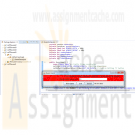
CIS355A iLab 5 GuessGame and Text File I/O Java Programs
$15.00CIS355A iLab 5 GuessGame and Text File I/O Java Programs
In this lab you will create a single program that creates and reads a sequential file. All outputs must be GUI-based without using JOptionPane.
Deliverables
Program files for each of the following two programs
1. GuessGame
2. Text File I/OiLAB STEPS
STEP 1: GuessGame
Write a program named GuessGame.java that plays the game “guess the number” as follows: Your program chooses the number to be guessed by selecting an integer at random in the range 1–1000. The program then displays the following in a label.
I have a number between 1 and 1000 -- can you guess my number?
Please enter your guess: ____________________
A JTextField should be used to input the guess. A JButton must be provided to allow the user to press each time a guess is entered. As each guess is input, the background color should change to either red or blue. Red indicates that the user is getting warmer, and blue indicates that the user is getting colder. A JLabel should display either Too High or Too Low to help the user zero in on the correct answer. When the user gets the correct answer, Correct! should be displayed, and the JTextField used for input should be cleared and changed to be uneditable. Also, a JButton should be provided to allow the user to play the game again. When the New Game JButton is clicked, a new random number should be generated and the input JTextField changed to be editable. A JButton must be provided to allow the user to exit the application. Also provide a count of the number of guesses the user entered when the correct number is guessed.STEP 2: Text File I/O (20 points)
Learn More
Write a program called TextFileIO.java to create a file named numbers.dat. Then create an algorithm that writes all even numbered integers from 1 to 100, separated by a comma. After the file has been created, close and reopen the file and display the results to the screen. After the results have been displayed append the odd number integers from 1 to 100, separated by a comma to the end of the file. Reopen the file and display the results. The contents of the file should be the even numbers from 1 to 100 separated by a comma followed by the odd number from 1 to 100 separated by a comma. The output of this program would be something like the following
2,4,6,8,10,12,14,……,98,100
2,4,6,8,10,12,14,……,98,100,1,3,5,7,9,……..97,99 -
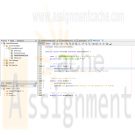
CMIS 141 Project 3 Stringed Musical Instrument Java Class and UML class diagram
$25.00CMIS 141 Project 3 Stringed Musical Instrument Java Class and UML class diagram
This project focuses on demonstrating your understanding of classes and objects. Before attempting this project, be sure you have completed all of the reading assignments listed in the syllabus to date, participated in the weekly conferences, and thoroughly understand the examples throughout the chapters. The project requirements include:
1. Design and implement a stringed musical instrument class using the following guidelines:
a. Data fields for your instrument should include number of strings, an array of string names representing string names (e.g. E,A,D,G), and boolean fields to determine if the instrument is tuned, and if the instrument is currently playing. You are welcome to add additional data fields if you like.
b. A constructor method that set the tuned and currently playing fields to false.
c. Other methods 1) to tune the instrument, 2) to start the instrument playing, and 3) to stop the instrument from playing.
d. Other methods as you see fit (Add at least one unique method).2. Create a UML class diagram using a diagram tool (e.g. PPT, Visio) of your choice. Prepare the diagrams and place them in a word document along with a brief description of each of your classes.
3. Create Java classes for your instruments. Be sure that your code matches your design specifications and some minimal functionality is included. For example, if you called the violin.play() method, you should at least print that the violin is playing. Similar functionality should be supplied when you stop playing, tune or call any of your methods. For example:
public void playviolin() {
System.out.println("The violin is now playing.");
}4. Write the output from your Instrument class methods to a text file that a user entered from the command line arguments (e.g. java Mynamep3tst myfilename.txt). This allows your program to accept filenames from the user via a command line argument.
5. Finally, create a Java test class that simulates using your instrument class. In your test class be you should at a minimum: a) Construct 10 instances of your instrument, b) tune your instruments, c) Start playing your instrument, d) Call your unique method, and e) Stop playing your instruments. (Hint: Arrays and Loops will make your job easier and result in more efficient code!)
6. Your programs should compile and run without errors.
7. Be sure to test your program carefully. Provide a list of comprehensive test cases used to validate your application and include these test cases in your word document containing your UML diagrams and descriptions. Similar to Project 1, your test data can be shown in a table that includes input data, expected output, actual output and pass/fail results from the test.
Learn More -

Dreams Travel Agency Java GUI Both parts
$20.00Dreams Travel Agency Java GUI Both parts
Learn More
Field of Dreams Travel Agency has begun offering travel packages to baseball fans wanting to attend major league baseball games. The company offers a package allowing a fan to attend games in four cities of his or her choice, including transportation by car, tickets, lodging, and food. Assume that the fan lives in the city hosting one of the 30 major league baseball teams. The fan will travel from his or her home to the city of one of the teams of his choice, then will proceed to the city of one of the other teams and so on until all teams have been visited. Then, the fan will return home. Create a Java program that will compute the minimum cost of the trip. Your cost will be the cost of transportation (fuel cost per gallon/ miles per gallon * number of miles between ballparks), cost of tickets, cost of lodging, and cost of food. Ask the user his home city, which cities he wants to visit, the price of fuel, the fuel economy of his vehicle, the cost of lodging per day and the cost of food per day. Your program will compute the costs of all 24 possible routings and choose the minimum cost route. Mark up the minimum cost by 20% to arrive at the cost that will be quoted to the customer.
For this week, you need only to create the GUI using Java Swing and create the basic classes that will accept the inputs from the user. We will create the functionality of these classes in the second assignment.
We will discuss strategies for preparing this program in the first week of class and you can create the program in the second week of class. That is done and I have a program with no function so here is the second part: Expand the model classes you created in the first assignment. Implement the functionality that will use the inputs offered by the user and prepare a quote for the customer according to the requirements specified in the first assignment. Upon clicking a Quote button on the GUI, the program should post a dialog box with the quote. Upon clicking the Print Quote button, write the quote out to a text file. This program was built on NETBEANS -
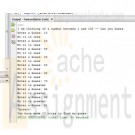
Game of Guessing Numbers Java Program
$5.00Game of Guessing Numbers Java Program
In a game of guessing numbers, one person says "I am thinking of a number between 1 and 100". The second person guesses "50". The first person says "No it is less". The second person guesses "20". The first person says "No it is greater". This continues until the second person guesses the number. Write a program that plays this game. The computer knows the number (a random number between 1 and 100). The user (the second person) is the guesser. At the end of the program, the computer must displays the number of guesses it took the user to guess the number.
The program must include:
A main class
A loop (for, while or do-while)
An if or if – else statement
Must accept input from the keyboard
Must have a prompting statement
A separate class with a constructor
At least one method that performs an operation required by the main programHERE IS AN ALGORITHM, PLEASE MAKE IT AS SIMPLE AS YOU CAN AND STILL INCLUDE THE NECESSARY RULES.
Learn More
• Prompt
• Generate a random number (1-100)
Computer = gen random # (1-100)
Do (input number (kb Reader)
Stop = false;
{
If (myNum = computeNum
Stop = true
{
(System.out.println(“You win!”);
}
Else
If (myNum>computeNum)
{
System.out.println(“Your number is too high);
}
Else
If (myNum<computeNum)
{
System.out.println(“Your number is too low”);
}
} -
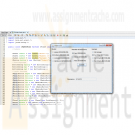
Penn Foster Exam 40254500 Construction Company Java Program
$15.00Penn Foster Exam 40254500 Construction Company Java Program
Write an application for a construction company to handle a customer's order to build a new home. Use separate ButtonGroups to allow the customer to select one of four models, the number of bedrooms, and a garage type. Assume that the models are the Aspen, $100,000; the Brittany, $120,000; the Colonial, $180,000; or the Dartmoor, $250,000. Assume that any model can have two, three, or four bedrooms and that each bedroom adds $10,500 to the base price. Assume that the garage type can be zero-, one-, two-, or three-car, and that each car adds $7,725 to the price. Save the file as JMyNewHome.java.
Learn More -
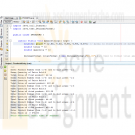
ITS 320 Assignment 3 Decision Control and Loops with User Interaction
$15.00ITS 320 Assignment 3 Decision Control and Loops with User Interaction
1) Write a Java application that prompts the user for pairs of inputs of a product number (1-5), and then an integer quantity of units sold (this is two separate prompts for input values). You must use a switch statement and a sentinel – controlled loop (i.e. a loop that stops execution when an out of range value, such as -1, is input). All 15 items below are for a single purchase. There are five sets of inputs as follows:
Product 1 1 unit (cost is $2.98 per unit)
Product 2 2 units (cost is $4.50 per unit)
Product 3 3 units (cost is $9.98 per unit
Product 4 4 units (cost is $4.49 per unit)
Product 5 5 units (cost is $6.87 per unit)
Your application must calculate and display the total retail value of all products sold, after all 5 pairs of inputs are completed. You must also display the total after each new pair of input values is entered. (This program was taken from Exercise 5.17 on page 228 of Deitel & Deitel's "Java How to Program (Sixth Edition)" (2005 by Pearson Publishing Co.))2) You may use the Windows Command Prompt command line interface or any Java IDE you choose to compile and execute your program.
3) You are to submit the following deliverables to the Assignment Dropbox in a single Microsoft Word file:
A screen snapshot of your Java source code (just the beginning is OK) as it appears in your IDE (e.g. jGRASP, Net Beans, Eclipse, etc.) or editor (e.g. a Windows Command Prompt DOS "more" of the .java file's first screen).
A listing of your entire Java source code in the same Microsoft Word file as item a), and following item a). You can simply copy and paste the text from your IDE into Word. Be sure to maintain proper code alignment by using Courier font for this item.
A screen snapshot of your program’s input and output in the same Microsoft Word file, and following item b). You must include screen snapshots of all inputs and all outputs,not just a sample.4) Your instructor may compile and run your program to verify that it compiles and executes properly.
5) You will be evaluated on (in order of importance):
Learn More
Inclusion of all deliverables in Step #3.
Correct execution of your program.
Adequate commenting of your code.
Good programming style (as specified in the textbook's examples).
Neatness in packaging and labeling of your deliverables -
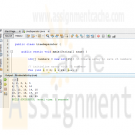
ITS 320 Assignment 4 Separate lines Java Program
$15.00ITS 320 Assignment 4 Separate lines Java Program
1. Write a program to assign the integer values 1 through 25 to a 25 element integer array. Then, print the array as five separate lines each containing five elements separated by commas. The last element on each line should be followed by a newline instead of a comma. The output of your program should appear exactly as follows:
1,2,3,4,5
6,7,8,9,10
11,12,13,14,15
16,17,18,19,20
21,22,23,24,25Hints:
Learn More
One way to determine every 5th element is to use the modules operator (%). If you divide the subscript by 5 and the remainder is 0, it is the 5th number.
You can use System.out.print() to print a value without a newline following it. This will allow you to print multiple things on the same line.
You may use the Windows Command Prompt command line interface or any Java IDE you choose to compile and execute your program.




